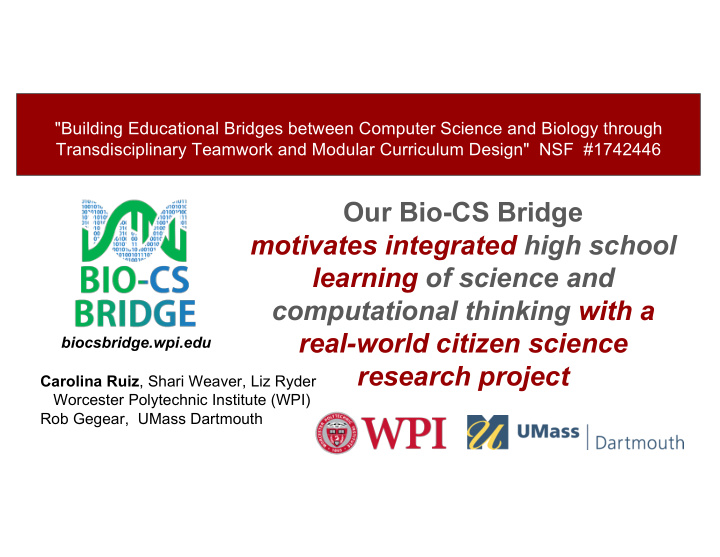



"Building Educational Bridges between Computer Science and Biology through Transdisciplinary Teamwork and Modular Curriculum Design" NSF #1742446 Our Bio-CS Bridge motivates integrated high school learning of science and computational thinking with a real-world citizen science biocsbridge.wpi.edu research project Carolina Ruiz , Shari Weaver, Liz Ryder Worcester Polytechnic Institute (WPI) Rob Gegear, UMass Dartmouth
Motivation for our Research Questions High Impact Teaching Practices Adapted from Richard F. Vaz. "High-Impact Practices Work". Inside Higher Ed. June 4, 2019 Some Benefits and Challenges : High-impact teaching practices: ● promote active engagement ● involve collaboration, in and out of project-based learning ● classroom settings ● can push students and teachers out of community-based learning ● their comfort zones - thoughtful involving students in research ● implementation and support are needed for students and teachers to succeed ➔ WPI has been devoted to Ugrad Project-Based Learning very successfully for 50+ years ➔ How can we share this expertise and transfer these high-impact practices to high schools?
We are investigating: Engaging Student Learning with a Real-world Citizen Science Research Project project-based learning + community learning + involvement in research Pollinator Decline Research Bio-CS Bridge Dr. Gegear (Co-PI) & Dr. Ryder (PI) Engages students and teachers in scientific practices using biological data they collect, and computational tools they help to design and implement general public: citizen scientists
We are also investigating: Transdisciplinary Team ● active engagement ● collaboration ● expertise sharing ● joint curriculum Vertical Integration: high school & univ. development and student and faculty implementation partnership ● thoughtful implementation and support for students & teachers to succeed Horizontal Integration : biology and computer science
Insights: What we have learned so far ● Teachers report strong student ● Communication is key engagement in initial pilot in 2 schools ○ Learning to speak each other’s language ○ Students enjoy collecting real ○ Teacher input into software and tutorial data and contributing to a development is key research database ○ What do teachers need to teach? New ○ Using and creating simulations ways to convey content and websites deepens learning ○ Using e-communication tools effectively ● Transdisciplinary team process was ● Creating cognitive artifacts – visuals are critical in generating truly integrated important curriculum that fits teachers’ needs ● Presenting our work as a group – cohesion ● Creating a balance – all perspectives and feedback are essential – horizontal and vertical
Next Steps Short Term (as part of this grant) : Continue implementation & assessment of our curriculum and team approach Long Term (in future work) : Creating a blueprint for other university/high school partnerships around the country/world to: ○ form transdisciplinary teams ○ develop project-based, research-motivated curricula and student learning experiences: ■ in other Biological research problems + C ■ in other STEM disciplines + C ■ in non-STEM disciplines (e.g., Humanities) + C
"Building Educational Bridges between Computer Science and Biology through Transdisciplinary Teamwork and Modular Curriculum Design" NSF #1742446 Thank you biocsbridge@wpi.edu biocsbridge.wpi.edu Carolina Ruiz , Shari Weaver, Liz Ryder Worcester Polytechnic Institute (WPI) Rob Gegear, UMass Dartmouth
Recommend
More recommend